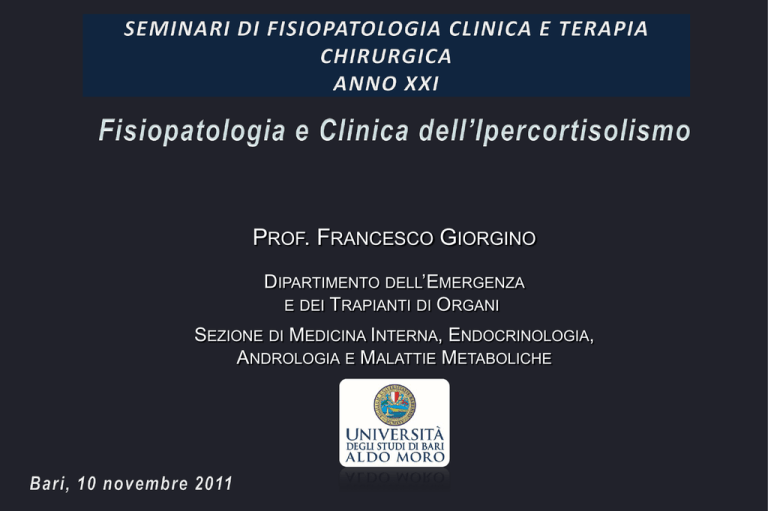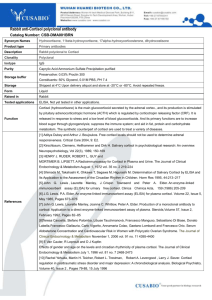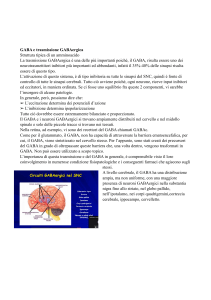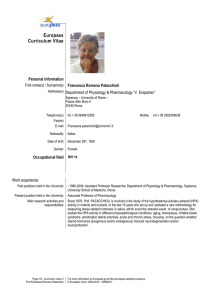Adrenal Incidentaloma
advertisement

PROF. FRANCESCO GIORGINO DIPARTIMENTO DELL’EMERGENZA E DEI TRAPIANTI DI ORGANI SEZIONE DI MEDICINA INTERNA, ENDOCRINOLOGIA, ANDROLOGIA E MALATTIE METABOLICHE • “incidentaloma” - mass lesions discovered serendipitously during an imaging investigation. • Endocrine glands (pituitary, thyroid, parathyroid and adrenal) represent the organs that most commonly harbor incidentally discovered lesions. Vassiliadi, D. A. & Tsagarakis, S. Nat. Rev. Endocrinol. 7, 668–680 (2011); Kloos, R. T., Gross, M. D., Francis, I. R., Korobkin, M. & Shapiro, B. Incidentally discovered adrenal masses. Endocr. Rev. 16, 460–484 (1995). Adrenal lesions are bilateral in 8–17% of cases in radiological studies76–78 and 20% in autopsy studies. In one autopsy study that considered lesions <2 mm, bilateral nodularity was seen in 19 of the 21 cases in which both glands were examined. An adrenal incidentaloma is a mass lesion greater than 1 cm in diameter, serendipitously discovered by radiologic examination. Discovery of an adrenal mass raises 3 questions that determine the degree of evaluation and the need for therapy: 1. Is the tumor hormonally active? 2. Does it have radiologic features of malignant lesion? 3. Does the patient have a history of previous malignancy? Corticosurrene Midollare Adenoma Feocromocitoma Mielolipoma Iperplasia nodulare Ganglioneuroma Ganglioneuroblastoma Carcinoma Altre masse Neurofibroma Amartoma Teratoma Xantomatosi Amiloidosi Cisti Ematoma Granulomatosi Metastasi Carcinoma mammario Carcinoma polmonare Linfoma Leucemia Altri “Is it malignant?” Metastases in the adrenals are common. In oncologic patients up to 20% and 40% of adrenal incidentalomas are metastasis in radiology and post-mortem cohorts, respectively (Barzon L et al, Eur. J. Endocrinol. 2003). Adrenal cortical carcinoma is rare (2.5-9.0%, surgical series; 1.4%, unselected patients), but shows high mortality rate (Barzon L et al, Eur. J. Endocrinol. 2003; Cawood T J et al, Eur. J. Endocrinol. 2009). Adenomas 52% Carcinomas 12% Mantero F et al, J Clin Endocrinol & Metab, 2000 Others 8% Pheo 11% 3 rare types of nodular adrenocortical diseases that are usually bilateral: ACTH-dependent bilateral macronodular hyperplasia secondary to long-term adrenal stimulation in patients with Cushing's disease (pituitary ACTH-secreting tumor) or ectopic ACTH syndrome ACTH-independent bilateral macronodular adrenal hyperplasia (AIMAH) Due to aberrant adrenal expression of ectopic or increased activity of eutopic peptide hormone receptors (GIP, vasopressin, beta-adrenergic, LH/hCG, serotonin, and angiotensin receptors) ACTH-independent micronodular hyperplasia or dysplasia and its most frequent variant, primary pigmented nodular adrenocortical disease (PPNAD) May be sporadic or familial (as part of the Carney complex, due to PRKAR1A, PDE11A, PDE8B, and MYH8 gene mutations) Tumor size Adrenocortical carcinoma <4 cm 2% 4.1-6.0 cm 6% >6 cm 25% Mantero F et al, J Clin Endocrinol & Metab, 2000 Mansmann et al, Endocr Rev, 2004 “Is it functioning?” The possible presence of a functioning mass is often suggested by the history (e.g., palpitations, sweating, or headache [Pheocromocytoma]), physical examination (e.g., features of Cushing's syndrome, hypertension, virilization [Androgen-secreting tumors]), and routine laboratory findings (e.g., hypokalemia [Primary aldosteronism]). Subclinical hormone overproduction by incidentalomas may be associated with increased morbidity. “The presence of an inapparent adrenal mass does not mean absence of endocrine activity. The patient with an adrenal mass requires a complete history and physical examination, biochemical evaluation of all pertinent hormones, and possibly additional radiological studies.” Mansmann et al, Endocr Rev, 2004 PREVALENZA DI PATOLOGIA: analisi del Gruppo di Studio Italiano sugli Incidentalomi Surrenalici (1004 pazienti) 6% 3% 1% 90% Adenomi non secernenti Adenomi con sindrome di pre-Cushing Feocromocitomi Aldosteronomi Mantero F et al, J Clin Endocrinol & Metab, 2000 La Sindrome di Cushing Obesità tronculare, gibbo di bufalo Faccia a “luna piena” Ipertensione arteriosa Intolleranza glicidica, diabete Irsutismo, acne Disfunzioni sessuali: Amenorrea Impotenza Osteoporosi, Rachialgie Calcolosi renale Astenia muscolare Strie purpuree Fragilità vasale, ecchimosi Alterazioni psichiche Scompenso cardiaco Subclinical Cushing Syndrome (SCS) Subclinical Autonomous Glucocorticoid Hypersecretion (SAGH) Subclinical Hypercortisolism (SH) a mild but autonomous cortisol hypersecretion from adrenal adenoma detected serendipitously without any previous suspect of adrenal disease without signs or symptoms of Cushing's syndrome (> 5% of all adenomas) Distinct from preclinical Cushing’s syndrome (early stage in the development of patent Cushing’s syndrome). Increased prevalence of hypertension, central obesity, diabetes/IGT, hyperlipoproteinemia; increased cardiovascular risk; reduced BMD. High prevalence of disturbed glucose tolerance (61%) in patients with nonfunctional adrenal incidentaloma (no abnormal low-dose suppression test). Development of postoperative hypocortisolism. Benefit of surgery not clear (consider clinical expression and life expectancy). Terzolo M et al, Clin Endocrinol 2011 µg/dL 5.0 1.8 Consider presence of MS or osteoporotic fractures further investigation by measurement of ACTH, UFC, or late-night salivary cortisol. Terzolo M et al, Clin Endocrinol 2011 Chiodini I et al, JCEM 2011 INCIDENTALOMA SURRENALICO ED ALTERAZIONI METABOLICHE (133 pazienti) prevalenza delle alterazioni glicemiche 27,41% 43,70% 12,59% 16,30% Diabetici IGT NGT OGGT non eseguito Insulina Recettore Insulinico GLUT4 P Tyr Membrana Plasmatica Tyr P PI 3-Chinasi IRS-1 Tyr P Glucosio Subunità Regolatoria PI Subunità Catalitica PI 3-P Docking Fusione PDK1 Thr308 P Akt “PDK2” Ser473 P GLUT4 P Ser P Ser Traslocazione GLUT4 Captazione Glucosio Ser P AS160 Ser P GLUT4 Storage Compartment Insulina Recettore Insulinico P Tyr IRS-1 IRS-1 IRS-1 IRS-1 Tyr P Tyr P Tyr P Tyr P Tyr P PI 3-Chinasi PI Subunità Subunità Regolatoria PI 3-PCatalitica Subunità PI Subunità Regolatoria PI Catalitica 3-P TRASMISSIONE SEGNALE Subunità Regolatoria Subunità Regolatoria Subunità Regolatoria Subunità Regolatoria Subunità Catalitica Insulina Recettore Insulinico P Tyr IRS-1 IRS-1 IRS-1 IRS-1 Tyr P PI 3-Chinasi Tyr P Subunità Regolatoria Tyr P Subunità PI Subunità Regolatoria PI Catalitica 3-P Tyr P Tyr P Subunità Regolatoria Subunità Regolatoria Subunità Regolatoria TRASMISSIONE RIDOTTA SEGNALE Subunità Regolatoria Subunità Catalitica Subunità Regolatoria Subunità p85a Regolatoria Condizione Tessuto Referenza Eccesso di glucocorticoidi Muscolo scheletrico Giorgino F, J. Biol. Chem., 1997 Giorgino F, J. Clin. Invest., 1995 Eccesso di GH Muscolo scheletrico Tessuto adiposo Barbour LA, J. Biol. Chem., 2005 Del Rincon JP, Diabetes, 2007 GH placentare Muscolo scheletrico Barbour LA, Endocrinology, 2004 Soggetti insulino-resistenti/DT2 Muscolo scheletrico Bandyopadhyay GK, Diabetes, 2005 Soggetti dopo carico calorico Muscolo scheletrico Cornier M-A, Diabetologia, 2006 Donne post-partum Muscolo scheletrico Kirwan J, JCEM, 2004 Improve the adverse metabolic profile Decrease cardiovascular risk Reverse some unnoticed symptoms of mild hypercortisolism, including proximal myopathy, fatigue or cognitive impairment Prevent the improbable progression to overt hypercortisolism with its unquestionable morbidity Vassiliadi, D. A. & Tsagarakis, S. Nat. Rev. Endocrinol. 7, 668–680 (2011); Endocrine evaluation ■■Exclude pheochromocytoma: urinary fractionated metanephrines or plasma free metanephrines ■■Exclude hyperaldosteronism: in patients with hypertension use aldosterone to renin ratio; if ratio is increased, test further with saline infusion ■■Exclude autonomous cortisol secretion: cortisol level after dexamethasone suppression (1 mg overnight or low-dose dexamethasone suppression test (four times 0.5 mg for 2 days); midnight cortisol (serum or salivary); 24 h urinary free cortisol; morning ACTH levels; consider measuring DHEAS levels Failure to suppress after dexamethasone combined with another positive test makes the diagnosis probable. Review possible confounding factors, such as medications or patient compliance. In case autonomous cortisol secretion is documented, check for features of the metabolic syndrome (for example, with OGTT) and osteoporosis. Indications for surgery (always exclude pheochromocytoma first) ■■Size >6 cm and/or imaging characteristics suggesting malignancy ■■Increase in size ■■Functioning tumor ■■Pheochromocytoma: surgery ■■Primary hyperaldosteronism: surgery if unilateral disease is confirmed ■■Autonomous cortisol secretion: well-established criteria for surgery are lacking; consider surgery if comorbidities are present or in cases of clearly abnormal endocrine tests


